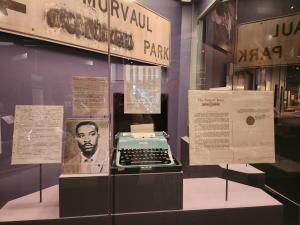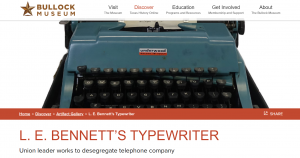
Bullock Museum of Texas History

Rev. Dr. L.E. Bennett exhibit behind glass

Old Faithful, Bennett’s typewriter
Large respected Austin, Texas museum unveils new exhibit of civil rights leader who devoted most of his life to his community and equal rights for Black Texans.
— Rev. Dr. Martin Luther King
AUSTIN, TX, USA, June 14, 2023/EINPresswire.com/ — Located three blocks from the city’s capital in downtown Austin, the Blue Star Bullock Museum of Texas State History is named for the state’s 38th Lieutenant Governor, Bob Bullock. He championed the preservation and exhibition of Texas history and worked to establish the museum that opened in 2001. Over 9 million people have visited the museum since its inception. Bullock’s mission is to create experiences that educate, engage, and encourage a deeper understanding of Texas, with core values of Leadership, Excellence, Accessibility, Diversity, Engagement, and Relevance woven throughout. Through their collection you can gain a better understanding of the generations that came before.
“We are thrilled to be able to share the story of Rev. Dr. L.E. Bennett with our visitors,” said Bullock Museum Curator, Angie Glasker. “His commitment to justice and equality is an inspiration to us all, and we hope that his story will encourage our guests to learn more about the civil rights movement in Texas.”
The exhibit in the artifacts gallery will feature his personal artifacts and documents from Bennett’s life, including his photograph, his prized typewriter, Old Faithful, used to type numerous letters to government officials, local and national. As well as correspondences requesting job advancement for people of color.
In June 1956, twenty-three-year-old L. E. Bennett began working for Southwestern Bell Telephone Company as a house serviceman, the company’s term for janitors. At the time, people of color could only apply for janitorial and garage positions. But none of the higher paying positions that the company called craft jobs, like linemen, operators, or salespeople. Shortly after being hired, Bennett joined then local chapter 6131 of the Communication Workers of America Colored People’s Union, the segregated arm of the Communication Workers of America (C.W.A.) and was elected Chapter President in 1961.
As president of the Communication Workers of America Colored People’s Union, he played a vital role in desegregation.
In Bennett’s role as President, he applied pressure to Southwestern Bell management and lobbied for support from his white C.W.A. counterparts. He began a letter writing campaign to company division heads and the national C.W.A. president asking for support to allow people of color to apply for craft positions. He was met with hostility from the C.W.A. president, who was adamant that the union would not integrate and refused to work with Bennett. Southwestern Bell managers were more amenable but were still apathetic to desegregation, believing that Black and white employees could not work side-by-side without conflict.
The numerous letters L.E. Bennett wrote included to national civic leaders like Martin Luther King, Jr., and then-Attorney General Robert F. Kennedy. In his return letter of support, Attorney General Kennedy agreed with Bennett that Southwestern Bell was not adhering to President Kennedy’s Executive Order that required government contractors, like AT&T and its subsidiaries, “take affirmative action to consider applicants and employees during employment without regard to their race, creed, color, or national origin.” Kennedy also wrote that the federal government would step in if the company continued to refuse to integrate, and he recommended Bennett use his letter during meetings to further pressure Southwestern Bell management into desegregating. The action of showing that letter didn’t make him popular with leadership; however, Bennett eventually gleaned some key supporters.
In the summer of 1963, Southwestern Bell conceded and allowed people of color to apply for craft positions. That winter, two linemen positions became available in Corpus Christi. After eight years of being denied promotions to better-paying jobs, Bennett accepted one of the positions, becoming the first Black lineman in the company in Texas.
Bennett rose through the ranks during his 30 years with Southwestern Bell, becoming the first Black man in the positions he held. When he retired in 1986, he was a second-level manager overseeing a five-state district.
Rev. Dr. L.E. Bennett was born in Louise, TX, with a family history that nurtured and provided his identity with skills enabling him to navigate a negative diverse world. Raised in a Christian household, L.E. continued to practice his faith and work in the church. He and his wife gave their four children the same upbringing. He graduated Magna Cum Laude and was Valedictorian in high school. L.E. attended St. Philips College in San Antonio, finishing an associate degree with honors. Subsequently, he was a Business Major at St. Mary’s University, later continuing to a degree and doctorate in theology. He loved the Lord and education. March 1988, Bennett was ordained as a minister and shortly thereafter became pastor of the Galilee Missionary Baptist Church on San Antonio’s west side. For him the community remained paramount leading him to serve on company boards, meet with city council, forge improvements and rehabilitations in housing.
Rev. Dr. L.E. Bennett’s accomplishments were noticed and rewarded by numerous companies, organizations, and individuals. Such as, Mr. Roy Wilkins, former national president of the NAACP, Ms. Rosa Parks and the Wall of Tolerance, Former President Bill Clinton, and Former Senator Ruth Jones McClendon to name a few.
What he did was pivotal in the community; especially, for those wanting corporate jobs. Bennett’s work is now being recognized by this illustrious museum available for all to see. His daughter, Sharon K. Bennett has written his detailed biography entitled: Jewel of the South civil rights biography of Rev. Dr. L.E. Bennett, which evokes deep emotions.
Sharon Bennett
n/a
[email protected]
![]()










































